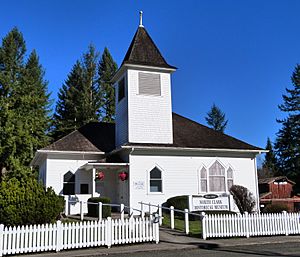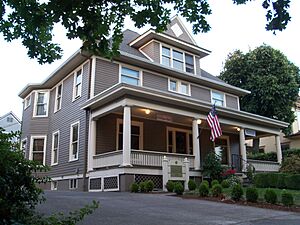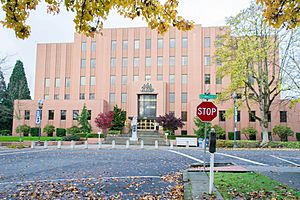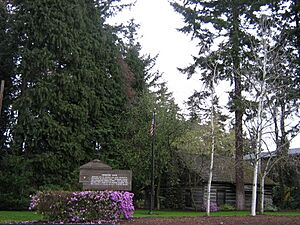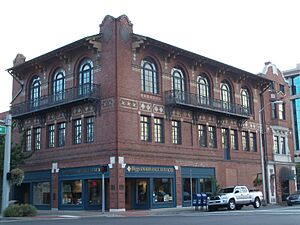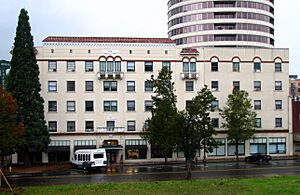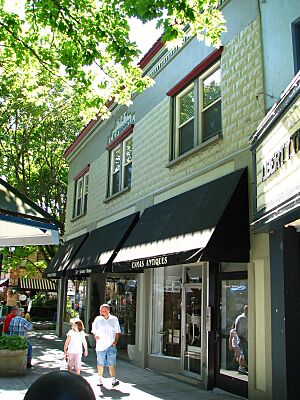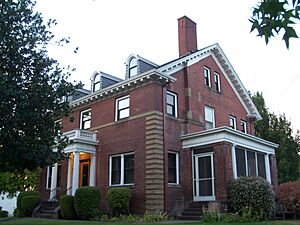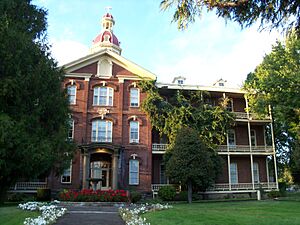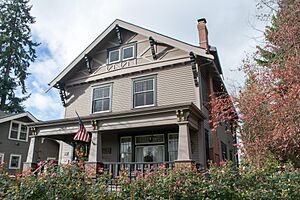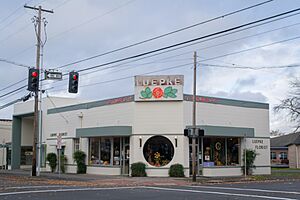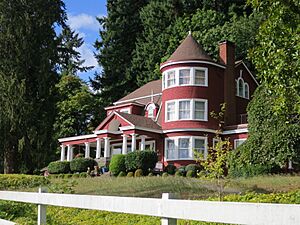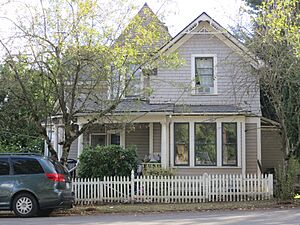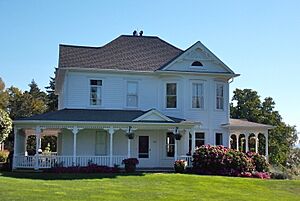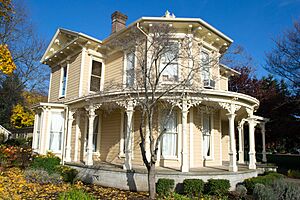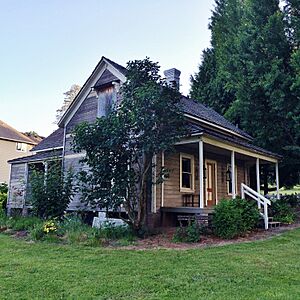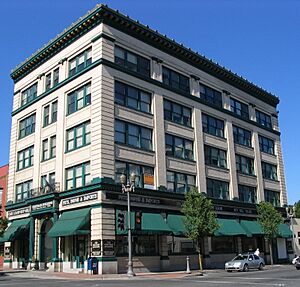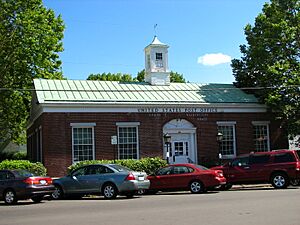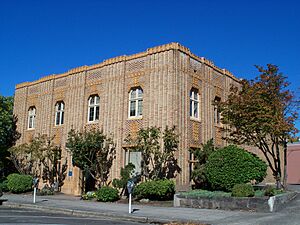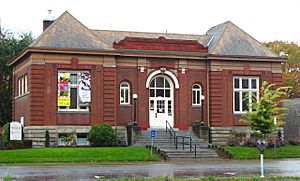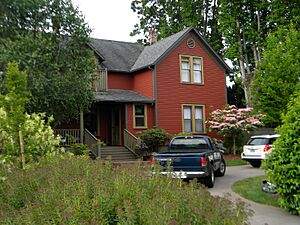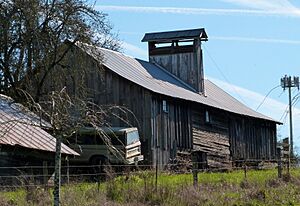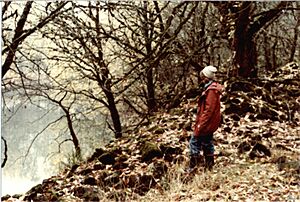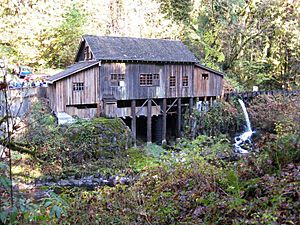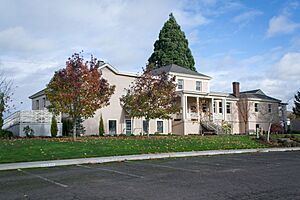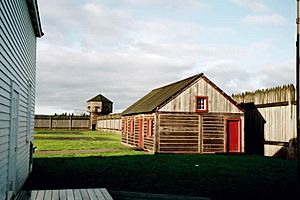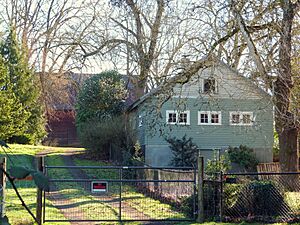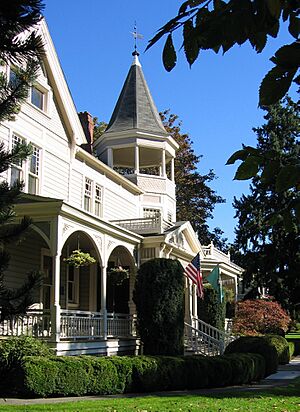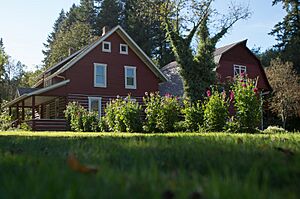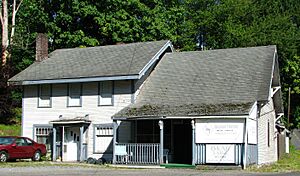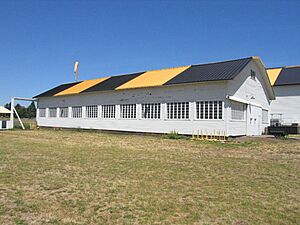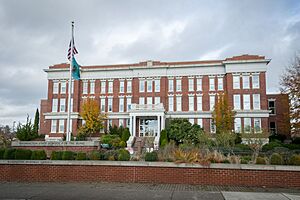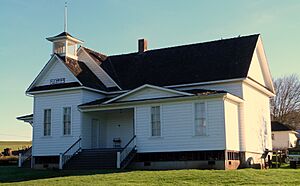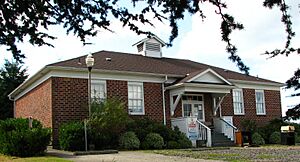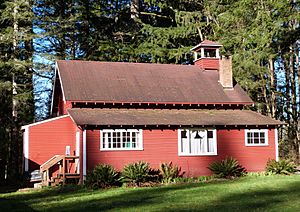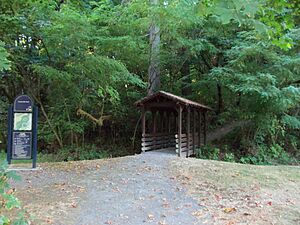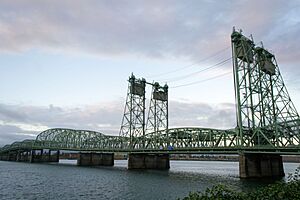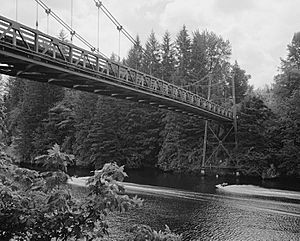National Register of Historic Places listings in Clark County, Washington facts for kids
The National Register of Historic Places is a special list in the United States. It includes buildings, places, and objects that are important to American history. When a place is on this list, it means it's worth saving and protecting for future generations. Clark County, Washington, has many amazing places on this list. Let's explore some of them!
Contents
- Historic Buildings and Homes
- Amboy United Brethren Church
- Chumasero–Smith House
- Clark County Courthouse
- Covington House
- Elks Building
- Evergreen Hotel
- Farrell Building
- Hidden Houses
- House of Providence
- John P. and Mary Kiggins House
- Luepke Florist
- Pittock House
- John Roffler House
- William Henry Shobert House
- Slocum House
- John Stanger House
- U.S. National Bank Building
- U.S. Post Office – Camas Main
- U.S. Post Office – Vancouver Main
- Vancouver Telephone Building
- Vancouver Public Library (Clark County Historical Museum)
- Historic Sites and Districts
- Anderson–Beletski Prune Farm
- Arndt Prune Dryer
- Basalt Cobblestone Quarries District
- Cedar Creek Grist Mill
- Clark County Poor Farm – Southwestern Washington Experiment Station
- Fort Vancouver National Historic Site
- Heye H. and Eva Meyer Farmstead
- Officers Row, Fort Vancouver Barracks
- Pomeroy Farm
- Sara Store
- Vancouver National Historic Reserve Historic District
- Washington School for the Blind
- Historic Schools
- Bridges and Parks
- Former Listings
- Images for kids
- See also
- External links
Historic Buildings and Homes
Clark County is home to many old and interesting buildings. These places tell stories about how people lived long ago.
Amboy United Brethren Church
The Amboy United Brethren Church was built in 1909. It is a beautiful old church located in Amboy. This building shows the history of the community and its early settlers. It was added to the National Register in 2008.
Chumasero–Smith House
The Chumasero–Smith House is in Vancouver. It was built in 1898. This house is a great example of the Victorian style of architecture. It shows how wealthy families lived at the turn of the 20th century. It joined the list in 1998.
Clark County Courthouse
The Clark County Courthouse is a very important building in Vancouver. It was built in 1941. This is where many legal and government decisions are made for the county. It was added to the National Register in 2014.
Covington House
The Covington House is one of the oldest homes in Vancouver. It was built in 1848. This house is a rare example of early pioneer architecture in the area. It became a historic place in 1972.
Elks Building
The Elks Building in Vancouver was built in 1912. It is a grand building that once housed the Benevolent and Protective Order of Elks. This group was important in the community. The building joined the National Register in 1983.
Evergreen Hotel
The Evergreen Hotel, built in 1909, is another historic spot in Vancouver. It was a popular place for travelers and locals. Hotels like this were central to city life. It was added to the list in 1979.
Farrell Building
The Farrell Building is in Camas. It was built in 1907. This building is a good example of early commercial architecture. It shows how businesses operated in the early 1900s. It became a historic site in 2006.
Hidden Houses
The Hidden Houses are two homes in Vancouver built in 1900 and 1901. They are called "Hidden Houses" because they are tucked away. They show typical homes from that time. They were added to the list in 1978.
House of Providence
The House of Providence in Vancouver was built in 1873. It was originally a home for orphans and a hospital. It played a big role in caring for the community. It joined the National Register in 1978.
John P. and Mary Kiggins House
This house in Vancouver was built in 1907. It belonged to John P. Kiggins, who was a well-known businessman. The house is a beautiful example of early 20th-century design. It was added to the list in 1995.
Luepke Florist
Luepke Florist, built in 1939, is a unique historic site in Vancouver. It's an example of a long-standing family business. It shows how local shops were important to the community. It joined the list in 2016.
Pittock House
The Pittock House in Camas was built in 1902. It was the home of a prominent family in the area. This house represents the early development of Camas. It became a historic site in 1979.
John Roffler House
The John Roffler House in Camas was built in 1907. It is another example of a well-preserved historic home. It reflects the architectural styles popular at the time. It was added to the list in 1993.
William Henry Shobert House
This house in Ridgefield was built around 1900. It is a good example of a farmhouse from that period. It shows the rural history of Clark County. It joined the National Register in 1979.
Slocum House
The Slocum House in Vancouver was built in 1867. It is one of the oldest surviving homes in the city. It has a unique design and tells a story of early Vancouver residents. It was added to the list in 1973.
John Stanger House
The John Stanger House in Vancouver was built in 1900. This house is a good example of early 20th-century farmhouses. It shows the agricultural past of the area. It became a historic site in 1990.
U.S. National Bank Building
The U.S. National Bank Building in Vancouver was built in 1912. It's a grand building that shows the importance of banks in the city's growth. It has a classic architectural style. It joined the list in 1988.
U.S. Post Office – Camas Main
This Post Office in Camas was built in 1937. It's a great example of government buildings from that time. Post offices were vital for communication. It was added to the list in 1991.
U.S. Post Office – Vancouver Main
The Vancouver Main Post Office was built in 1936. Like the Camas one, it shows the important role of postal services. It has a classic design typical of the era. It joined the National Register in 1991.
Vancouver Telephone Building
The Vancouver Telephone Building was built in 1909. This building shows the early history of telephone communication. It was a key part of how people connected. It became a historic site in 1986.
Vancouver Public Library (Clark County Historical Museum)
This building in Vancouver was built in 1909. It was originally a Carnegie library. These libraries were built with money from Andrew Carnegie. Today, it houses the Clark County Historical Museum. It joined the list in 1982.
Historic Sites and Districts
Some places on the National Register are not just single buildings. They are larger areas or sites that hold historical importance.
Anderson–Beletski Prune Farm
This prune farm in Vancouver was active for many years. It shows the history of farming in Clark County. Prunes were an important crop. It was added to the National Register in 1986.
Arndt Prune Dryer
The Arndt Prune Dryer near Ridgefield was built in 1925. It's a special building used to dry prunes. This shows how food was processed long ago. It became a historic site in 1979.
Basalt Cobblestone Quarries District
This district is located within the Ridgefield National Wildlife Refuge. It's where basalt rock was quarried, or dug up, to make cobblestones. These stones were used for streets and buildings. It joined the National Register in 1981.
Cedar Creek Grist Mill
The Cedar Creek Grist Mill, built in 1876, is east of Woodland. A grist mill grinds grain into flour. This mill is still working today! It shows how food was made in the past. It was added to the list in 1975.
Clark County Poor Farm – Southwestern Washington Experiment Station
This site in Vancouver has a long history. It was first a "poor farm" where people in need could live and work. Later, it became an experiment station for farming. It shows how society helped people and developed agriculture. It joined the list in 2013.
Fort Vancouver National Historic Site
This is a very important historical site in Vancouver. Fort Vancouver was a major fur trading post in the 1800s. It was a center of activity for many different people. It became a National Historic Site in 1966.
Heye H. and Eva Meyer Farmstead
This farmstead in Vancouver shows the history of farming in the area. It includes a house and barn. It tells the story of families who worked the land. It was added to the National Register in 2015.
Officers Row, Fort Vancouver Barracks
Officers Row is a street in Vancouver with many historic homes. These homes were built for army officers stationed at Fort Vancouver Barracks. They show the military history of the area. It became a historic district in 1974.
Pomeroy Farm
The Pomeroy Farm in Yacolt is a historic farm that shows rural life. It gives us a look into how farming families lived and worked. It was added to the National Register in 1987.
Sara Store
The Sara Store in Ridgefield was built in 1910. It was a general store, selling all sorts of goods to the community. Stores like this were important gathering places. It became a historic site in 1995.
Vancouver National Historic Reserve Historic District
This large district in Vancouver includes many important historic places. It helps protect and share the history of the area. It joined the National Register in 2007.
Washington School for the Blind
The Washington School for the Blind in Vancouver was established in 1886. It has helped many students learn and grow. The historic district was added to the National Register in 1993.
Historic Schools
Several old school buildings in Clark County are on the National Register. They show how education has changed over time.
Glenwood School
The Glenwood School, built in 1925, is near Glenwood. It's a classic example of a small rural schoolhouse. These schools were once the heart of many communities. It was added to the list in 1992.
Lambert School
The Lambert School in Ridgefield was built in 1909. Like Glenwood, it's a rural school that served local children. It shows the history of education in the county. It joined the National Register in 1989.
Venersborg School
The Venersborg School, built in 1912, is near Battle Ground. This school also represents the history of rural education. It was a central place for learning and community events. It was added to the list in 1989.
Bridges and Parks
Even bridges and parks can be historic! They are important parts of our infrastructure and recreation.
Lewisville Park
Lewisville Park near Battle Ground is a historic park. It was created in 1914 and is one of the oldest parks in Clark County. It offers a look at early park design. It joined the National Register in 1986.
Vancouver–Portland Bridge (Interstate Bridge)
This bridge spans the Columbia River between Vancouver and Portland, Oregon. It was built in 1917. It's a vital link between the two states and a marvel of engineering for its time. It was added to the list in 1982.
Yale Bridge
The Yale Bridge spans the Lewis River near Yale. It was built in 1932. This bridge is important for its design and its role in connecting communities. It joined the National Register in 1982.
Former Listings
Sometimes, a place might be removed from the National Register. This can happen if it is changed too much or destroyed.
Ridgefield American Women's League Chapter House
This house in Ridgefield was built in 1910. It was once a meeting place for the American Women's League. It was listed in 1982 but later removed in 1990.
Images for kids
See also
- National Register of Historic Places listings in Washington state
- Listings in neighboring counties: Columbia, Cowlitz, Multnomah, Skamania
- Historic preservation
- History of Washington (state)
- Index of Washington-related articles
External links
- Washington Department of Archaeology and Historic Preservation, Historic Register program
- National Park Service, National Register of Historic Places site


